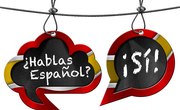In any language, it can be helpful to know how to talk about the time. Knowing how to discuss time is beneficial when getting around a foreign country and when holding basic conversation, but it is also an effective way to ensure that you understand how to communicate numbers in a given language. In Spanish, the word for time is "el tiempo," and translating the time from English to Spanish is a great way to practice both your numbers and your understanding of basic conjugation. As long as you understand both of these, you can use a few simple phrases to talk about time in Spanish and use that knowledge to broaden your understanding of the language as a whole.
Basics of telling time
To translate the time to Spanish from English, more than anything, you'll need to know the Spanish words for the cardinal numbers, or the numbers one through 12 (which appear on a clock's face). In order, these numbers translate to uno, dos, tres, cuatro, cinco, seis, siete, ocho, nueve, diez, once and doce. While it helps to know your numbers up to 60 in Spanish, these 12 numbers are the minimum required to tell time and communicate it to another person since they are used to establish the hour.
To be more specific about what time it is, you'll need to use a second number to establish the minute. Twenty, 30, 40 and 50 in Spanish translate to viente, treinta, cuarenta and cincuenta, respectively. By using the word "y" (which translates to "and"), you can combine these numbers to form a larger number. "Cuarenta y tres" is 43, for example. The exception comes with the numbers 21 through 29, which simply pull "viente" and the other number together – veinticinco is 25, veintiseis is 26, veintisiete is 27 and so on. With this in mind, you can translate any time from English to Spanish.
How to translate time to Spanish
Before you attempt to translate the time into Spanish time, you'll need to know what time it is first, but once you know that, you can use your numbers and a few phrases to communicate the time. To say the hour in Spanish, use the phrase "es las" (if the hour is 1:00) or "son la" (if the hour is 2:00 through 12:00) followed by the appropriate number. For example, to say it is 1:00, you would say "es las una," while if it's 5:00, you can simply say "son la dos" and be done. "Las" is used in reference to the number one, which is expressed as "una" rather than "uno" when telling time.
Adding minutes to the phrase is as simple as adding "y" followed by the appropriate number. To say that it's 7:23, you would say "son la siete y vientitres," while 9:45 would be expressed as "son la nueve y cuarenta y cinco." Once you've gotten the hang of this, you can easily incorporate some common phrases to talk about time.
Talking about time in Spanish
While you can say the time using "es las" and "son la," it's important to know more casual and conversational ways of discussing time. If someone says "que hora es," for example, you should know that he's asking you what time is it. "La hora" is another word for time, used to refer to the time of day rather than the broad concept of time. The phrase "en punto" is used to say "exactly," as in "es las una en punto" to say that it's exactly 1:00 or "son las cinco en punto" to say that it's precisely 5:00.
Fifteen and 30 minutes are usually expressed as "cuarto" and "media" instead of "quince" and "treinta," and you can subtract from the hour to say it's however many minutes until an hour by using "menos." For example, "es la una y media" means that it's 1:30, while "son las diez y quince" means that it's 10:15 or a quarter past 10. "Son las tres menos cuarto" means that it's a quarter to three, or 2:45. You can further add to your sentences by adding the phrases "de la manana," "de la tarde" and "de la noche" to express that it's morning or daytime (día), afternoon or night, respectively. Therefore, “medianoche” means midnight and “mediodía” means noon. With this knowledge and more vocabulary, you can easily hold a conversation about time.
Tip
unlike in english, Spanish doesn’t use a translation for o’clock
when in doubt, ask a native spanish speaker if you are a beginner spanish learner
minuto is used when counting the number of minutes
spanish doesn’t use a 24 hour clock
Related Articles
References
Tips
- If the time is 11:15, you can say, "Son las once y cuarto," which means that it's quarter past 11. If the time is 11:30, you can say, "Son las once y media." "Media" means half. It is customary to use Step 5 in the Spanish-speaking world, but you can use the standard way if the customary way is too confusing. It's good to know both.
Writer Bio
Blake Flournoy is a writer, reporter, and researcher based out of Baltimore, MD. Working independently and alongside professors at Goucher College, they have produced and taught a number of educational programs and workshops for high school and college students in the Baltimore area, finding new ways to connect students to biology, psychology, and statistics. They have never seen Seinfeld and are deathly scared of wasps.










